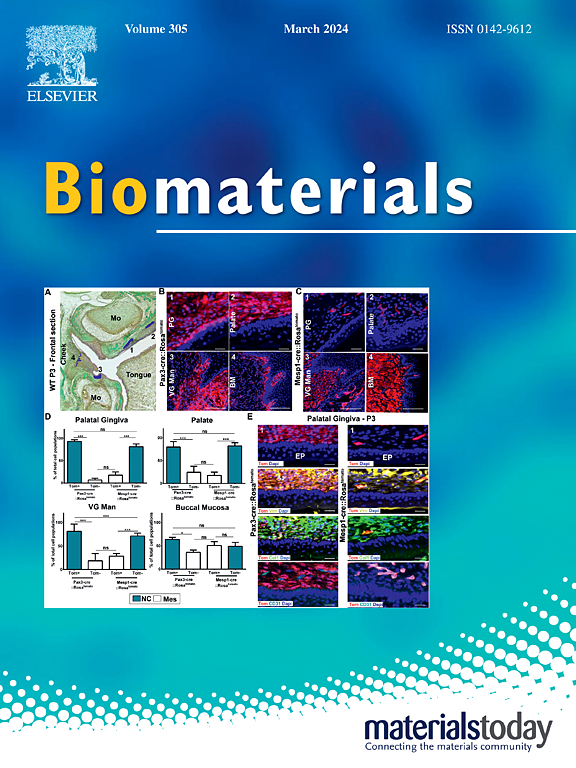A multifunctional mitochondria-protective gene delivery platform promote intervertebral disc regeneration
IF 12.8
1区 医学
Q1 ENGINEERING, BIOMEDICAL
引用次数: 0
Abstract
Intervertebral disc degeneration (IDD) is a deleterious condition driven by localized inflammation and the associated disruption of the normal homeostatic balance between anabolism and catabolism, contributing to progressive functional abnormalities within the nucleus pulposus (NP). Despite our prior evidence demonstrating that a miR-21 inhibitor can have regenerative effects that counteract the progression of IDD, its application for IDD treatment remains limited by the inadequacy of current local delivery systems. Here, an injectable tannic acid (TA)-loaded hydrogel gene delivery system was developed and used for the encapsulation of a multifunctional mitochondria-protecting gene nanocarrier (PHs). This engineered platform was designed for the sustained on-demand delivery of both miR-21 inhibitor and ss-31 (mitochondrial-targeted peptide) constructs to the NP. This prepared hydrogel could be implanted into the intervertebral disc using a minimally invasive approach whereupon it was able to rapidly release TA. Sustained PHs release was then achieved as appropriate through a mechanism mediated by the activity of MMP-2. Following the targeted uptake of PHs by degenerated NP cells, the subsequent release of encapsulated miR-21 inhibitor suppressed apoptotic cell death and modulated the metabolism of the extracellular matrix (ECM) by targeting the Spry1 gene. At the same time, ss-31 was able to target damaged mitochondria and alleviate inflammatory activity via the suppression of mitochondrial ROS-NLRP3-IL-1β/Caspase1 pathway activity. Synergistic ECM regeneration and anti-inflammatory effects were sufficient to provide therapeutic benefits in an in vivo model of IDD. Together, these results thus highlight this hydrogel-based gene delivery platform as a promising novel approach to the treatment of IDD.
多功能线粒体保护基因传递平台促进椎间盘再生。
椎间盘退变(IDD)是一种由局部炎症和相关的合成代谢和分解代谢之间正常稳态平衡的破坏引起的有害疾病,导致髓核(NP)内进行性功能异常。尽管我们之前的证据表明miR-21抑制剂可以具有抵消IDD进展的再生作用,但其在IDD治疗中的应用仍然受到当前局部递送系统不足的限制。本研究开发了一种可注射单宁酸(TA)负载的水凝胶基因传递系统,并将其用于多功能线粒体保护基因纳米载体(ph)的包封。该工程平台旨在将miR-21抑制剂和ss-31(线粒体靶向肽)构建物持续按需递送到NP。该制备的水凝胶可以通过微创入路植入椎间盘,从而能够快速释放TA。然后通过MMP-2活性介导的机制适当地实现持续的小灵通释放。在退化的NP细胞靶向摄取PHs后,随后释放被封装的miR-21抑制剂,通过靶向Spry1基因抑制凋亡细胞死亡并调节细胞外基质(ECM)的代谢。同时,ss-31能够靶向受损线粒体,通过抑制线粒体ROS-NLRP3-IL-1β/Caspase1通路活性来减轻炎症活性。在IDD体内模型中,协同的ECM再生和抗炎作用足以提供治疗效益。总之,这些结果突出了这种基于水凝胶的基因传递平台作为治疗IDD的一种有希望的新方法。
本文章由计算机程序翻译,如有差异,请以英文原文为准。
求助全文
约1分钟内获得全文
求助全文
来源期刊

Biomaterials
工程技术-材料科学:生物材料
CiteScore
26.00
自引率
2.90%
发文量
565
审稿时长
46 days
期刊介绍:
Biomaterials is an international journal covering the science and clinical application of biomaterials. A biomaterial is now defined as a substance that has been engineered to take a form which, alone or as part of a complex system, is used to direct, by control of interactions with components of living systems, the course of any therapeutic or diagnostic procedure. It is the aim of the journal to provide a peer-reviewed forum for the publication of original papers and authoritative review and opinion papers dealing with the most important issues facing the use of biomaterials in clinical practice. The scope of the journal covers the wide range of physical, biological and chemical sciences that underpin the design of biomaterials and the clinical disciplines in which they are used. These sciences include polymer synthesis and characterization, drug and gene vector design, the biology of the host response, immunology and toxicology and self assembly at the nanoscale. Clinical applications include the therapies of medical technology and regenerative medicine in all clinical disciplines, and diagnostic systems that reply on innovative contrast and sensing agents. The journal is relevant to areas such as cancer diagnosis and therapy, implantable devices, drug delivery systems, gene vectors, bionanotechnology and tissue engineering.
 求助内容:
求助内容: 应助结果提醒方式:
应助结果提醒方式:


